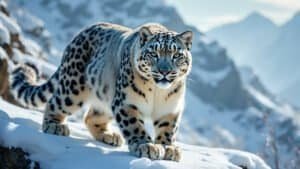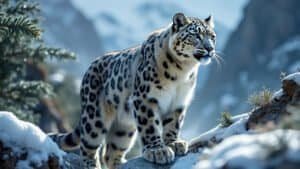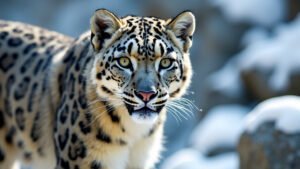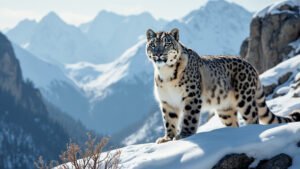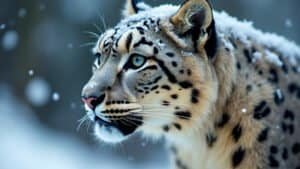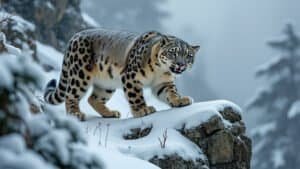Introduction
Genetic studies have become an essential tool in the conservation and reintroduction of snow leopards into their natural habitats. These studies provide insights into the genetic diversity and health of populations, which are crucial for selecting suitable reintroduction sites and ensuring the long-term survival of the species
In this article, we will explore the role of genetics in wildlife conservation, the methods used for genetic analysis, and the challenges faced by conservationists. Additionally, we will discuss how genetic data informs the process of selecting reintroduction sites and maintaining healthy, genetically diverse populations of snow leopards
The Role of Genetic Studies in Snow Leopard Conservation
Genetic studies play a critical role in modern wildlife conservation, especially for elusive and endangered species like the snow leopard. Understanding the genetic makeup of snow leopard populations provides vital information about their genetic diversity, population structure, and evolutionary history
This genetic knowledge helps conservationists make informed decisions when planning reintroduction efforts, ensuring the reintroduced population’s long-term survival and adaptability. By examining genetic data, researchers can identify potential genetic bottlenecks, inbreeding risks, and the need for genetic management strategies
What Are Genetic Studies?
Genetic studies involve analyzing the DNA of organisms to understand their genetic composition, relationships, and evolutionary processes. For snow leopards, these studies typically include DNA sequencing, genetic marker analysis, and mitochondrial DNA studies
DNA sequencing helps in understanding the genetic variation within and between populations, while genetic markers—specific sequences in DNA—are used to track inheritance patterns and population dynamics
Mitochondrial DNA, which is inherited maternally, can provide insights into the maternal lineage and historical population structure of snow leopards. These techniques collectively allow scientists to build a comprehensive genetic profile that informs conservation strategies
Importance of Genetics in Conservation
Genetic diversity is vital for the survival and adaptability of any species. For snow leopards, maintaining genetic diversity is essential to coping with environmental changes, disease outbreaks, and other unforeseen challenges. A genetically diverse population is more likely to possess individuals with the necessary traits to survive and reproduce in changing conditions
Research shows that low genetic diversity can lead to inbreeding depression, a condition that reduces fitness and can increase susceptibility to diseases and genetic disorders (Frankham, 2015)
Studies have shown that snow leopard populations are fragmented across their range in Central Asia, from the Himalayas to the mountains of Siberia. Fragmentation limits gene flow between populations, leading to isolated groups that are more vulnerable to genetic drift and inbreeding
By understanding these genetic dynamics, conservationists can prioritize actions such as translocations or habitat corridors to maintain or increase gene flow, ensuring healthier populations
Key Findings from Genetic Research on Snow Leopards
Genetic research has revealed several important insights into snow leopard populations. A study by Janecka et al. (2017) used genetic markers to show that snow leopards are divided into three major genetic clusters corresponding to their geographic distribution in the Himalayas, the northern range, and the western range
These clusters have significant genetic differences due to limited gene flow, indicating the need for distinct management strategies tailored to each group
Furthermore, genetic studies have identified “genetic hotspots,” areas with high genetic diversity that are crucial for maintaining the overall genetic health of the species. Protecting these hotspots and considering them in reintroduction plans can help ensure a stable, genetically diverse population
Another important finding is the identification of potential corridors that connect fragmented populations, allowing for gene flow and reducing the risks associated with isolated populations
Genetic research also helps in identifying individuals suitable for breeding programs and reintroduction efforts. By analyzing genetic profiles, conservationists can select individuals that contribute to a diverse gene pool, minimizing the risks of inbreeding and ensuring the reintroduced population has a robust genetic foundation
Genetic Diversity and Its Importance for Snow Leopards
Genetic diversity is crucial for the survival of any species, and this is especially true for endangered species like the snow leopard. The genetic variability within a population determines its ability to adapt to changing environments, resist diseases, and maintain overall health
For snow leopards, which face threats like habitat loss, poaching, and climate change, preserving genetic diversity is a cornerstone of effective conservation strategies. A genetically diverse population is more resilient and has a better chance of surviving the challenges posed by both natural and human-induced changes
Why Is Genetic Diversity Crucial?
Genetic diversity refers to the variety of genetic characteristics within a species’ population. It is crucial for several reasons
Firstly, it allows for adaptability. When a population has a wide range of genetic traits, it increases the likelihood that some individuals will have characteristics that enable them to survive changes in their environment, such as new diseases, climate shifts, or changes in prey availability. For snow leopards, living in the rugged terrains of Central Asia, adaptability is essential for survival
With their wide range spanning various countries and terrains, from the high altitudes of the Himalayas to the steppes of Mongolia, genetic diversity ensures that different populations can adapt to their specific environments
Secondly, genetic diversity reduces the risk of inbreeding depression. In small, isolated populations, like those often found in snow leopards, inbreeding can occur when closely related individuals mate. This can lead to a higher likelihood of genetic disorders and a decrease in reproductive fitness, which poses a severe risk to the population’s long-term survival
According to a study by Allendorf et al. (2013), populations with reduced genetic diversity are less capable of evolving in response to environmental changes, making them more vulnerable to extinction
Effects of Low Genetic Diversity on Snow Leopards
Low genetic diversity in snow leopards can have dire consequences for their survival and adaptability. One of the most significant risks is inbreeding depression, which can lead to a reduced ability to reproduce, lower survival rates of offspring, and increased vulnerability to diseases
For example, a genetically homogenous population might lack resistance to specific pathogens, leading to widespread mortality if an outbreak occurs
Additionally, low genetic diversity reduces the evolutionary potential of a population. Evolutionary potential is the ability of a population to adapt to environmental changes over time. If a snow leopard population lacks the genetic variation needed to cope with new challenges, its chances of survival decrease substantially
Fragmented populations, which are common in snow leopards due to habitat fragmentation and human encroachment, are particularly at risk. Genetic drift—random changes in the frequency of alleles in small populations—can further reduce genetic diversity over time, compounding these challenges
In the context of reintroduction, releasing individuals with low genetic diversity can lead to the establishment of a population that is not resilient in the face of environmental or anthropogenic stressors. Therefore, ensuring a diverse gene pool in reintroduced populations is a priority for conservationists
Case Studies of Genetic Diversity in Big Cats
The importance of genetic diversity is not unique to snow leopards; it is a common concern for the conservation of all big cats. For instance, the Florida panther (Puma concolor coryi) population faced severe inbreeding depression due to its small size and isolation
Conservationists introduced individuals from a different subspecies to increase genetic diversity, which led to an increase in population health and viability (Johnson et al., 2010). This example demonstrates how maintaining or increasing genetic diversity can help prevent inbreeding depression and promote population recovery
Similarly, the Amur leopard (Panthera pardus orientalis), one of the rarest big cats, has benefited from genetic studies that have informed breeding programs aimed at increasing genetic diversity. These efforts have helped maintain a viable population despite the severe fragmentation of its habitat in the Russian Far East
For snow leopards, these lessons highlight the need for careful genetic management in reintroduction programs. By ensuring that reintroduced individuals are genetically diverse, conservationists can create populations that are more robust and capable of adapting to changing conditions in their natural habitats
Methods and Techniques Used in Genetic Studies of Snow Leopards
Understanding the genetic structure and diversity of snow leopard populations is vital for effective conservation and reintroduction efforts. To achieve this, scientists employ a variety of methods and techniques to study the genetics of snow leopards
These methods help in collecting and analyzing genetic data, which is used to assess population health, plan reintroductions, and monitor the success of conservation strategies. The primary techniques include DNA sampling and analysis, the use of genetic markers, and non-invasive genetic monitoring
DNA Sampling and Analysis
DNA sampling is the cornerstone of genetic studies in wildlife conservation. For snow leopards, obtaining DNA samples can be challenging due to their elusive nature and the rugged, remote habitats they occupy
However, several methods have been developed to collect DNA from snow leopards without causing harm or distress to the animals. These methods include collecting tissue samples from live-captured individuals, obtaining blood samples from immobilized snow leopards, or even using hair snares that capture fur for DNA analysis
One of the most widely used approaches is the analysis of scat (fecal) samples. Snow leopards, like other carnivores, leave scat along their territories, which provides a non-invasive way to collect DNA
By analyzing the cells shed in scat, researchers can extract both nuclear DNA (nDNA) and mitochondrial DNA (mtDNA). This method is highly effective for studying elusive species and has been widely employed in snow leopard research (Waits & Paetkau, 2005)
Once collected, DNA is analyzed using several molecular techniques. Polymerase Chain Reaction (PCR) is commonly used to amplify specific regions of DNA, making it easier to study genetic variation
Next-Generation Sequencing (NGS) is another advanced technique that allows for the sequencing of entire genomes or specific gene regions, providing more detailed genetic information about snow leopard populations. This level of detail can reveal insights into genetic diversity, population structure, and evolutionary history
Use of Genetic Markers
Genetic markers are specific sequences of DNA that vary among individuals and can be used to study genetic differences within and between populations
For snow leopards, researchers often use microsatellites, which are short, repetitive sequences of DNA, as genetic markers. Microsatellites are highly polymorphic, meaning they have a high degree of variability, making them excellent tools for assessing genetic diversity
By analyzing microsatellite markers, scientists can estimate genetic diversity within snow leopard populations and identify genetic bottlenecks, which are events that reduce genetic variation and can threaten population viability
A study by Sharma et al. (2011) demonstrated the utility of microsatellites in evaluating genetic diversity across different snow leopard populations in India, revealing significant genetic structuring that has implications for their conservation
Single Nucleotide Polymorphisms (SNPs) are another type of genetic marker used in snow leopard studies. SNPs are variations at a single position in a DNA sequence among individuals
These markers provide a finer scale of genetic variation compared to microsatellites and can be used to study population genetics, gene flow, and adaptive potential. SNP analysis has been gaining traction in conservation genetics due to its potential for large-scale genetic analysis and higher resolution in detecting population differences
Non-invasive Genetic Monitoring
Non-invasive genetic monitoring has revolutionized wildlife genetics by providing a way to study species without physically capturing or disturbing them. For snow leopards, non-invasive monitoring techniques are particularly valuable due to the species’ elusive nature and the challenging terrain they inhabit
Apart from scat collection, non-invasive methods include collecting hair samples using barbed wire snares, analyzing environmental DNA (eDNA) from soil or water samples, and utilizing camera traps to identify individuals visually and collect associated biological samples
Environmental DNA (eDNA) is an emerging technique in conservation biology. It involves detecting genetic material that animals shed into their environment, such as skin cells, hair, or feces. For snow leopards, researchers can collect eDNA from snow or water sources in their habitat. This method has the advantage of covering large areas and detecting elusive species that are otherwise hard to study
Although still in its early stages, eDNA has shown promise in providing a non-invasive and efficient way to monitor snow leopard presence and distribution in the wild (Rees et al., 2014)
Camera traps combined with genetic sampling provide a powerful tool for population monitoring. When snow leopards are identified through unique fur patterns captured by camera traps, researchers can then match these visuals with genetic samples collected from the same areas
This method helps in building comprehensive profiles of individual snow leopards, allowing for more accurate population estimates and insights into their genetic diversity and health
Selecting Reintroduction Sites Based on Genetic Data
Choosing the right reintroduction sites is a critical step in conservation efforts for snow leopards. Reintroducing these big cats into their natural habitats is a complex process that requires careful planning and consideration of several factors, with genetic data playing a key role
Genetic studies provide insights into the genetic diversity and population structure of snow leopards, which help determine the most suitable areas for reintroduction to ensure the long-term survival of the species
This section will discuss how genetic data informs the selection of reintroduction sites, the balance between genetic diversity and habitat suitability, and examples of successful reintroduction efforts
How Genetic Data Guides Habitat Choice
Genetic data is essential in guiding the selection of habitat sites for snow leopard reintroduction. A key consideration is the genetic compatibility between the existing population (if present) and the individuals being reintroduced
The goal is to maximize genetic diversity while avoiding potential genetic incompatibilities that could result in inbreeding or genetic swamping—where the genetic makeup of a smaller population is overwhelmed by the introduction of individuals from a larger population
Genetic studies help identify “source” populations that are genetically diverse and healthy, making them ideal candidates for reintroduction efforts. By comparing genetic data from different snow leopard populations, conservationists can select release sites that would benefit from increased genetic diversity without compromising the local population’s genetic integrity
For instance, if a specific region shows signs of a genetic bottleneck or low genetic diversity, introducing individuals from a genetically diverse population could help bolster genetic health and resilience
Moreover, genetic data helps in understanding historical population dynamics and connectivity between habitats. By analyzing genetic markers, researchers can infer past migration routes, identify potential natural corridors, and assess the historical range of snow leopards
Reintroductions can then be planned in locations that would naturally support gene flow between populations, thereby increasing genetic diversity and reducing the risk of inbreeding
Balancing Genetic Diversity and Habitat Suitability
While genetic diversity is a crucial factor in selecting reintroduction sites, it must be balanced with the suitability of the habitat
A genetically ideal site is of little value if it does not provide adequate resources for snow leopards to survive and thrive. Factors such as prey availability, terrain ruggedness, human presence, and climate conditions all play essential roles in habitat suitability
Conservationists use a combination of genetic data and ecological assessments to identify the most viable reintroduction sites. For example, regions with a healthy prey base, minimal human-wildlife conflict, and suitable terrain for hunting and denning are preferred
At the same time, these regions should allow for sufficient genetic exchange with nearby populations to maintain genetic diversity. This balance between genetics and ecology is crucial for the long-term success of reintroduced snow leopard populations
Advanced tools like Geographic Information System (GIS) mapping are used to overlay genetic data with ecological and environmental data to visualize and assess potential reintroduction sites comprehensively
This multi-layered approach ensures that sites are selected not just based on genetic diversity, but also on the broader ecological context that supports snow leopard survival
Examples of Successful Reintroduction Sites
Several reintroduction efforts have been informed by genetic data to ensure the success and sustainability of the population
One such example is the reintroduction of snow leopards in parts of Mongolia, where genetic studies identified areas with reduced genetic diversity due to habitat fragmentation. By introducing individuals from more genetically diverse populations, conservationists have been able to enhance genetic variability, which helps reduce the risks associated with inbreeding and genetic drift
Another example is the reintroduction efforts in Kyrgyzstan, where genetic data has been used to guide the selection of suitable release sites that offer genetic connectivity to existing populations
Conservation programs like the Global Snow Leopard and Ecosystem Protection Program (GSLEP) have utilized genetic information to prioritize areas for reintroduction that support both ecological and genetic goals
Successful reintroduction requires continuous monitoring to ensure that the genetic diversity of the population remains robust. Genetic markers are used to track the genetic makeup of reintroduced individuals and their offspring, helping to assess the long-term success of these efforts and adapt strategies as needed
These examples underscore the importance of incorporating genetic data into reintroduction planning and highlight the potential for genetic studies to guide future conservation initiatives
Challenges in Genetic Data Collection and Analysis
Collecting and analyzing genetic data for snow leopards poses several challenges, from the logistical difficulties of working in remote, rugged terrains to the technical complexities of genetic analysis
Despite these challenges, genetic studies remain crucial for effective conservation and reintroduction strategies. Understanding these obstacles is key to improving the methods and technologies used in snow leopard conservation
This section will discuss the difficulties in collecting genetic samples, addressing genetic variability in small populations, and the technological and ethical considerations involved
Difficulties in Collecting Samples from Snow Leopards
One of the main challenges in genetic studies of snow leopards is the difficulty of collecting samples in the wild. Snow leopards inhabit some of the most remote and inaccessible regions in the world, including the high-altitude mountains of Central Asia
The harsh weather conditions, steep terrain, and low population densities make it extremely challenging for researchers to locate and collect biological samples from these elusive cats
Moreover, snow leopards are solitary and highly territorial, which further complicates sample collection. Traditional methods like capturing and immobilizing snow leopards for blood or tissue samples are not only logistically difficult but also pose a risk to the animal’s health and well-being
Consequently, conservationists have increasingly turned to non-invasive methods, such as collecting scat, hair, and environmental DNA (eDNA) samples, to gather genetic information
While non-invasive methods are less intrusive and safer, they come with their own set of challenges. For example, DNA extracted from scat or hair can be degraded due to environmental exposure, leading to incomplete or low-quality genetic data
The process of obtaining reliable DNA from such samples requires advanced laboratory techniques, often involving time-consuming and costly processes like DNA amplification and sequencing. Additionally, there is always the risk of contamination from other species, requiring meticulous protocols to ensure the purity of samples
Addressing Genetic Variability in Small Populations
Maintaining genetic variability in small, isolated populations of snow leopards is another significant challenge. Small populations are more vulnerable to genetic drift, a process where allele frequencies change due to random sampling effects rather than natural selection
Over time, this can lead to a loss of genetic diversity, making the population more susceptible to diseases, environmental changes, and inbreeding depression
For snow leopards, fragmented populations often become isolated due to habitat loss, climate change, and human activities. This isolation limits gene flow between populations, increasing the risk of genetic bottlenecks—events that significantly reduce genetic diversity
Conservationists face the challenge of addressing these genetic bottlenecks through managed breeding programs, habitat restoration to connect fragmented populations, and strategic reintroduction efforts
To manage genetic variability effectively, it is essential to understand the genetic structure and health of snow leopard populations. This involves not only collecting genetic data but also using advanced modeling techniques to predict the effects of different conservation interventions on genetic diversity
However, such models require accurate and comprehensive genetic data, which can be difficult to obtain given the challenges in sample collection and the costs associated with genetic research
Technological and Ethical Considerations
The technological aspect of genetic analysis has advanced significantly over the past decade, with new methods like Next-Generation Sequencing (NGS) providing deeper insights into genetic diversity and population structure
However, the use of these advanced technologies comes with its own set of challenges. NGS and other high-throughput sequencing methods are costly and require specialized laboratory facilities and expertise, which may not be available in countries where snow leopards are found. This often necessitates international collaboration and funding, which can be difficult to secure and sustain over the long term
There are also ethical considerations in genetic studies and conservation efforts. The process of capturing and handling snow leopards for sample collection must be carried out with minimal stress and harm to the animals
Additionally, the use of genetic data must respect local and indigenous communities’ rights and knowledge, especially when reintroduction and conservation efforts are conducted on lands traditionally managed by these communities. Ethical guidelines and clear communication with local stakeholders are essential to ensure that conservation programs are both scientifically sound and socially responsible
Another ethical concern involves the potential misuse of genetic data. As genetic technologies advance, there is a growing need to ensure that genetic information is not exploited for purposes that could harm wildlife or local communities. Data privacy and sharing agreements are critical in this context, requiring careful oversight and regulation
Conclusion
Genetic studies are invaluable in guiding the reintroduction of snow leopards into their natural habitats, providing critical insights into genetic diversity, population structure, and evolutionary history
These studies help identify genetically suitable populations for reintroduction, determine optimal sites that balance genetic diversity with habitat suitability, and manage the risks associated with low genetic variability and inbreeding. Despite the challenges of collecting and analyzing genetic data, advancements in non-invasive techniques and high-throughput sequencing have significantly improved our understanding of snow leopard genetics
However, these efforts must be conducted ethically, respecting both wildlife and the local communities that coexist with these magnificent big cats. As we continue to refine our genetic and conservation strategies, the ultimate goal remains clear: to ensure a thriving, genetically diverse population of snow leopards that can endure the challenges of their environment and the changing world


